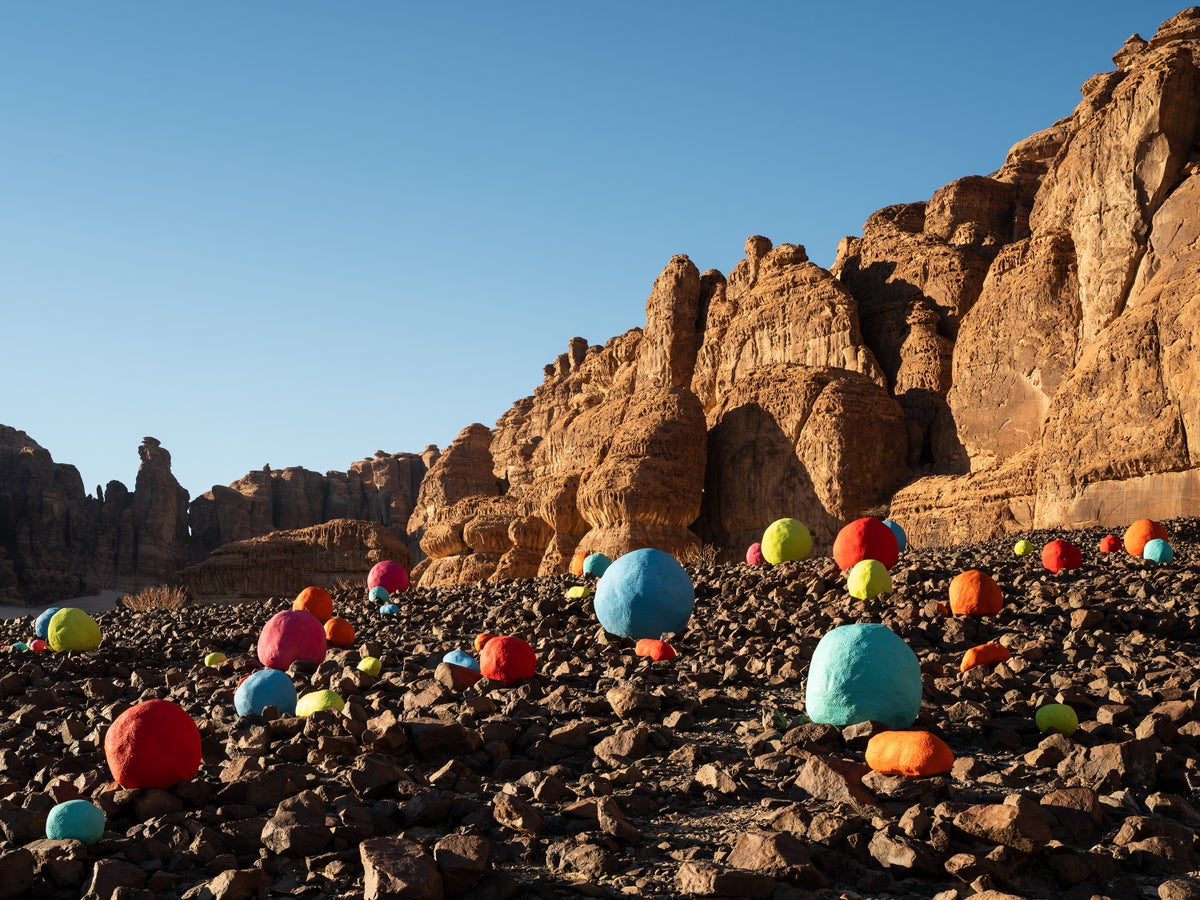
The studio of Helen Pashgian lies behind an old blue door in an alley in Los Angeles. The exterior is modest, yet inside are wonders that symbolise the power of the arts for AlUla, the natural and cultural heritage destination now taking shape in north-west Saudi Arabia.
On a recent morning, Ms Pashgian showed our visiting group an astounding work of art. It was a sphere of epoxy resin that sat upon a pedestal and must have weighed about 100kg. When she slowly lowered the lights in the studio, the edges of the sphere faded and then the entire disc somehow seemed to disappear. Then as she turned the lights slowly back up it reverted to radiant, glowing life.
Experiencing this artwork was a perfect, transcendent moment. And it is this sublimity that articulates our ambitions for the arts in AlUla – a transcendence through the universal language of the arts, blurring the borders that separate sand and sky, artist and audience, tourist and local, nation and neighbour, past and present, physical and spiritual.
Kholkhal Aliaa is inspired by a Bedouin anklet given to Sherin Guirguis by her mother
(Lance Gerber)
In the immediate future, this goal is driven by our first masterplan, The Journey Through Time. Under the masterplan, the Royal Commission for AlUla (RCU) by 2035 will create 15 new cultural assets delivering networked spheres of knowledge, immersion and creativity, culminating in the world’s largest Living Museum. Set around the cultural oasis, we will renew AlUla’s historical legacy as a nexus of artistic exploration, expression, and production through such offerings as the Arts District, the Perspectives Galleries, Incense Museum and Gardens, Oasis Living Gardens and – most relevant to our art trip to America – Wadi AlFann (Valley of the Arts).
Wadi AlFann’s epic landscapes will be a global destination for monumental art – with installations that rise from the sandy plains to create a dialogue with the canyons, outcrops, dunes and striated rock faces of the AlUla Valley.
Jeddah-based artist Zahrah AlGhamdi arranged around 6,000 tin date containers to create an artwork that resembles a river
(Lance Gerber)
Art in the landscape is one of AlUla’s most enduring legacies. For millennia, people in AlUla have inscribed, sculpted and carved unique reflections of the art of their time, with the landscape as their canvas. Rock art, sculpture, inscriptions, architecture… from the minute to the monumental, the creative monuments of AlUla are chapters in a global art history.
In the case of the UNESCO World Heritage Site of Hegra (an epic testament to the wealth and artistry of the ancient Nabataean kingdom), the symbols and motifs of ancient Egypt, Rome, Greece and Mesopotamia have been adopted and adapted alongside the local to adorn the colossal tombs, creating an open-air gallery exhibiting the dialogue of civilizations. The Incense Road – along which AlUla was a vital and thriving hub – also included maritime routes around the Red Sea and eastern Mediterranean, and Indian Ocean trade that ultimately connected with the Silk Road. That trade was a conduit for the exchange not only of incense but of ideas, art and architecture.
“Najma (She Placed One Thousand Suns on the Transparent Overlays of Space),” by the American artist Lita Albuquerque. It was the first sculpture of a woman on public display in modern Saudi Arabia, according to Desert X
(Lance Gerber)
It is this legacy – of the world coming together in the spirit of cultural transfer, to create extraordinary reflections of our time that will be a source of wonder and inspiration for generations to come, within the storied and spectacular landscapes of AlUla – that steers our vision for art in the landscape.
We began to revive this legacy during the inaugural Desert X AlUla in early 2020. Driven by the Royal Commission’s Director of Arts and Cultural Programming, Nora Aldabal and co-curated by Desert X artistic director Neville Wakefield and the Saudi curators Raneem Farsi and Aya Alireza, this exceptional exposition of art in the landscape featured works by 14 artists from around the world that integrated the landscape of the wadi into startling, eye-catching, and thought-provoking installations.
Exemplary among them was Now You See Me, Now You Don’t by the Saudi artist Manal Aldowayan, in which big round trampolines formed a path along the valley floor. Few were the visitors who could resist jumping aboard and, for brief moments, floating in mid-air amidst our sandstone canyons. Other installations in perfect dialogue with the landscape included a stylized swing set, a sculpted mound of Arabic script drawn from a love poem, a ghostly film-negative video of camels gliding across the desert, and a sculpture of an ultramarine astronaut from the 25th century.
The Future is Now, by artist Gisela Colon, draws a subtle comparison between human time and geological time
(Lance Gerber)
The advent of Desert X AlUla was in parallel to the mobilisation of programming at Madrasat Addeera, the AlUla Arts and Design Centre. Sited within AlUla’s future Arts District, this former secondary school is now a hub for AlUla’s local artisans mentored to draw on the creative legacies of AlUla to craft distinct, high quality cultural products ranging from ceramics to jewellery. This is a taste of our activities that will nurture a flourishing creative industry, for the enrichment of all who live, work and journey to this oasis, as we craft the next chapter in AlUla’s legacy as a cradle of artistic inspiration, transfer and expression.
And as these artists and artisans develop, maybe someday a visitor from afar will knock on the door of a studio down an alley in AlUla and be amazed by the marvels inside.
Amr Almadani is CEO of the Royal Commission for AlUla
Related posts:
Views: 0
 RSS Feed
RSS Feed

















 August 8th, 2021
August 8th, 2021  Awake Goy
Awake Goy  Posted in
Posted in  Tags:
Tags: 
















